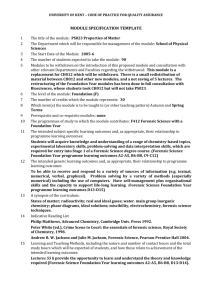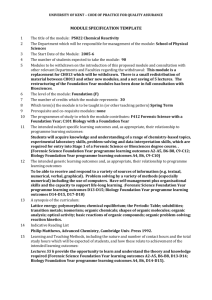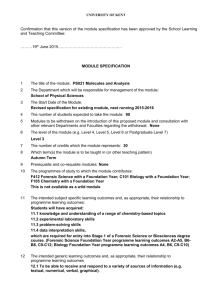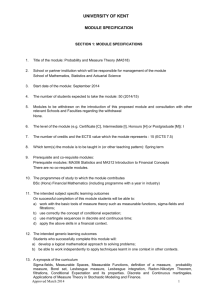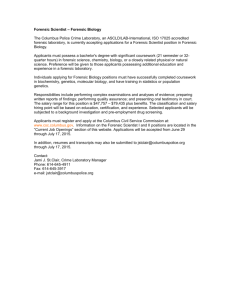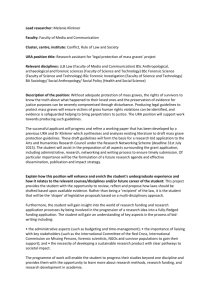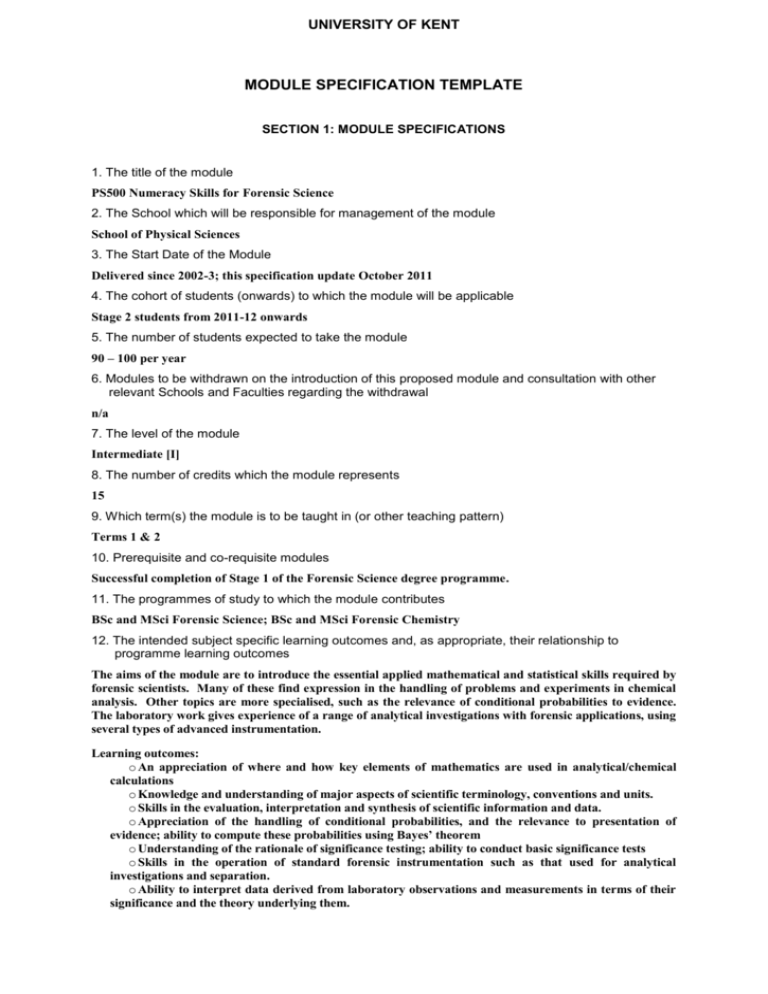
UNIVERSITY OF KENT
MODULE SPECIFICATION TEMPLATE
SECTION 1: MODULE SPECIFICATIONS
1. The title of the module
PS500 Numeracy Skills for Forensic Science
2. The School which will be responsible for management of the module
School of Physical Sciences
3. The Start Date of the Module
Delivered since 2002-3; this specification update October 2011
4. The cohort of students (onwards) to which the module will be applicable
Stage 2 students from 2011-12 onwards
5. The number of students expected to take the module
90 – 100 per year
6. Modules to be withdrawn on the introduction of this proposed module and consultation with other
relevant Schools and Faculties regarding the withdrawal
n/a
7. The level of the module
Intermediate [I]
8. The number of credits which the module represents
15
9. Which term(s) the module is to be taught in (or other teaching pattern)
Terms 1 & 2
10. Prerequisite and co-requisite modules
Successful completion of Stage 1 of the Forensic Science degree programme.
11. The programmes of study to which the module contributes
BSc and MSci Forensic Science; BSc and MSci Forensic Chemistry
12. The intended subject specific learning outcomes and, as appropriate, their relationship to
programme learning outcomes
The aims of the module are to introduce the essential applied mathematical and statistical skills required by
forensic scientists. Many of these find expression in the handling of problems and experiments in chemical
analysis. Other topics are more specialised, such as the relevance of conditional probabilities to evidence.
The laboratory work gives experience of a range of analytical investigations with forensic applications, using
several types of advanced instrumentation.
Learning outcomes:
o An appreciation of where and how key elements of mathematics are used in analytical/chemical
calculations
o Knowledge and understanding of major aspects of scientific terminology, conventions and units.
o Skills in the evaluation, interpretation and synthesis of scientific information and data.
o Appreciation of the handling of conditional probabilities, and the relevance to presentation of
evidence; ability to compute these probabilities using Bayes’ theorem
o Understanding of the rationale of significance testing; ability to conduct basic significance tests
o Skills in the operation of standard forensic instrumentation such as that used for analytical
investigations and separation.
o Ability to interpret data derived from laboratory observations and measurements in terms of their
significance and the theory underlying them.
UNIVERSITY OF KENT
o Ability to conduct risk assessments concerning the use of chemical substances and laboratory
procedures.
BSc/MSci Forensic Science Programme Specification Learning Outcomes 1, 3, 5, 14, 15, 19
13. The intended generic learning outcomes and, as appropriate, their relationship to programme
learning outcomes
BSc/MSci Forensic Science Programme Specification Learning Outcomes 8, 9, 11, 21, 22, 23, 24, 25, 27, 29
14. A synopsis of the curriculum
Trace Analysis [4 lectures, 1 coursework feedback class]
Trace analysis: definitions, methods and problems. Sampling, storage and contamination. Quality control.
Random and systematic errors; statistical treatment of data. Accuracy and precision. Signal/noise ratio.
Sensitivity and detection limits. Choice of methods for trace analysis.
Units, dimensions, exponentials and logarithms [5 lectures, 1 coursework feedback class]
Decimal places and significant figures. Units and dimensions: SI units, dimensional analysis. Manipulation
of exponentials and logarithms. Power laws. Exponential decay and half-life. Beer-Lambert law,
Arrhenius equation, Boltzmann distribution, Gaussian functions.
Chemical Arithmetic [3 lectures, 1 coursework feedback class]
Balancing chemical equations. Amount of substance, molar quantities, concentration and volumetric
calculations, gravimetric analysis, gas pressures and volumes.
Equilibrium calculations, strong and weak electrolytes. pH, acid-base equilibria, buffer solutions. Solubility.
Chemical kinetics: reaction rates, rate constants and orders of reaction.
Probability and Statistics [12 lectures, 2 coursework feedback classes]
Elementary probability, probability spaces, Venn diagrams, independence, mutual exclusion, expectation.
Quantitative treatment of the effect of evidence: Bayes’ Theorem and conditional probability
Samples and populations, mean, standard deviation, moments, standard error.
Probability distributions: binomial, normal, poisson. Limiting cases. Use of normal tables.
Significance testing and confidence limits.
Hypothesis testing. The chi-squared test.
A brief look at probability-based arguments used by expert witnesses, recent controversies and challenged
convictions.
Regression and correlation.
Laboratory work [6 three-hour sessions]
To include experiments such as:
Accelerant analysis by gas chromatography
Analysis of alkaloids by HPLC
Analysis of metal coins and cartridge cases using X-ray fluorescence spectroscopy
Determination of copper by atomic absorption spectroscopy
Isolation and purification of caffeine
Quantifying dye substances in a mixture using UV-visible spectroscopy
15. Indicative Reading List
S. K. Scott, “Workbooks in Chemistry – Beginning Mathematics for Chemistry” (Oxford, 1995).
ISBN 0198559305. [q QA 37.2]
P. Monk & L. J. Munro “Maths for Chemistry”, 2nd edition, (Oxford, 2010) ISBN 9780199541294
[QD 39.3.M3]
J. N. Miller and J. C. Miller, “Statistics and chemometrics for analytical chemistry”, 6th edition
(Pearson Prentice Hall 2010), ISBN: 9780273730422 [QD 75.4.S8]
D. Lucy “Introduction to statistics for forensic scientists”, (Wiley, 2005) ISBN 0 47 002201 9 [HV
8073]
M. R. Spiegel, “Schaum’s outline of theory and problems of probability and statistics” 4th edition
(McGraw Hill, 2008 & 2011) ISBN 9780071485845 [QA 276]
D. Rowntree “Statistics without tears”, (Penguin, 2000) ISBN: 9780140136326 [HA 29]. It’s nonmathematical and excellent for getting a grasp of concepts.
UNIVERSITY OF KENT
16. Learning and Teaching Methods, including the nature and number of contact hours and the total
study hours which will be expected of students, and how these relate to achievement of the
intended learning outcomes
Lectures 24 h provide the opportunity to learn and understand the theory and knowledge required to achieve the
learning outcomes.
Coursework feedback Classes 5 h develop knowledge and understanding of the module material and gives
practice in problem-solving and answering examination questions
Laboratory work 18 h develop experimental skills in several methods widely used in forensic science
Private study and revision (reading, coursework, preparation for assessment) 103 h
17. Assessment methods and how these relate to testing achievement of the intended learning
outcomes
Coursework
written assignments, covering each major section of the lectures: 20%
Laboratory work: 30%
Examination
(formal, written, unseen closed-book examination at end-of-year; 2 hours): 50%
Together these assessments will test achievement of all the intended learning outcomes.
18. Implications for learning resources, including staff, library, IT and space
Laboratory class: this is resource-intensive in terms of equipment and staffing. A budget is required for
the maintenance and replacement of laboratory equipment. A budget is required for sufficient postgraduate
demonstrator support.
Library resources: Multiple copies of the module’s core texts are available in the Templeman library.
The library resources must keep pace with the increased number of students on the module, and a budget is
necessary for this.
19. A statement confirming that, as far as can be reasonably anticipated, the curriculum, learning and
teaching methods and forms of assessment do not present any non-justifiable disadvantage to
students with disabilities
As far as can be reasonably anticipated, the curriculum, learning and teaching methods and forms of
assessment do not present any non-justifiable disadvantage to students with disabilities. The department
recognises and has embedded the expectations of SENDA, and supports students with a declared disability
or special (educational) need in its teaching, through the establishment of Inclusive Learning Plans agreed
between student, department and the Disability and Dyslexia Support Unit. We liaise with the Disability
and Dyslexia Support Unit in order to provide specialist support where needed.
SECTION 2: MODULE IS PART OF A PROGRAMME OF STUDY IN A UNIVERSITY SCHOOL
Statement by the School Director of Learning and Teaching/School Director of Graduate
Studies (as appropriate): "I confirm I have been consulted on the above module proposal and have
given advice on the correct procedures and required content of module proposals"
................................................................
Director of Learning and Teaching/Director of Graduate
Studies (delete as applicable)
..............................................
Date
…………………………………………………
Print Name
Statement by the Head of School: "I confirm that the School has approved the introduction of the
module and, where the module is proposed by School staff, will be responsible for its resourcing"
.................................................................
Head of School
..............................................
Date
UNIVERSITY OF KENT
…………………………………………………….
Print Name


